AZORES
History

History
Popular destinations PORTUGAL
| Algarve | Azores | Costa de lisboa |
| Costa verde | Madeira |
History
Geological history of the Azores
Just south of the North Pole to near the South Pole is the Mid-Atlantic Ridge, a mountain range, the longest on Earth, which is mostly submerged, but emerges here and there. The Mid-Atlantic Ridge plays a major role in the origin and geological future of the Azores. Mid-ocean ridges pull tectonic plates away from each other and the resulting space is filled with magma. This magma solidifies on the surface, causing volcanoes and other forms of volcanism to form. The separation of plates is an ongoing process and so there will always be the formation of new oceanic crusts.
The Mid-Atlantic Ridge, which moves apart up to 2 centimeters per year, separates the Eurasian and African plates in the east and the South and North American plates in the west. Some islands or archipelagos that live near or on the Mid-Atlantic Ridge include Jan Mayen (Arctic Ocean), Iceland (largest landmass ever created from oceanic crust), Bermuda, Ascension, Tristan da Cunha, Bouvet and the Azores.
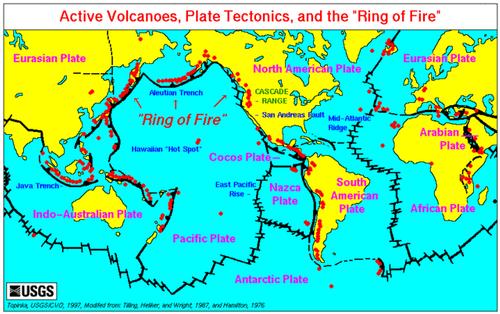 Mid-Atlantic Ridge positionPhoto: United States Geological Survey in the public domain
Mid-Atlantic Ridge positionPhoto: United States Geological Survey in the public domain
The situation for the Azores is a bit more complicated because there are three tectonic plates converging, so that the western islands of Flores and Corvo are on the North American plate and the other islands on the African plate, the Eurasian plate. lying on an Azorian microplate, that is still not entirely clear. The earthquakes that can be felt in the Azores, almost always less than 5.0 on the Richter Scale, are caused by magma flowing out through new cracks and fractures in the Earth's crust. These tremors may or may not be regular and six of the nine islands of the Azores have recently experienced eruptions and earthquakes, Corvo, Flores and Santa Maria are considered inactive.
Of the Central and Eastern Islands. Santa Maria first rose above sea level about five million years ago, but disappeared again under water due to tectonic activities. Approx. 4 million years ago, the Formigas Islets (located between São Miguel and Santa Maria) emerged, which is now the east of São Miguel and again Santa Maria. The marine fossils are from this time, which can only be found on Santa Maria. Originally composed of two islands, eastern São Miguel was formed from 290,000 years ago. Faial, Graciosa, São Jorge and Terceira are all younger than 1 million years, Pico is the 'youngest' island because it was only created about 300,000 years ago. The two western islands, Corvo and Flores, lie on the western flanks of the Mid-Atlantic Ridge;the oldest rocks in Flores date back to 2.5 million years ago and are below sea level;the youngest rocks are less than 3,000 years old.
As late as 1811, in barely a month, a completely new island appeared just to the east of São Miguel, 1.5 km long and about 100 meters wide. A British frigate was around there at the time, claimed the island and named it after the frigate's name, Sabrina. However, the British had already lost the island four months later, what it was swallowed up again in that short time by the sea and what remained was a sandbank some 40 meters below sea level. Recently, in 1957, an eruption west of Faial expanded the island with an additional 2 km2 of land.
Portuguese explorers discover the Azores
Until the 15th century, the Azores were an unspoilt area with no original inhabitants, no one had ever set foot on one of the islands or settled on it. The islands of the Azores were already well known in the 14th century, because the Medici Atlas from 1351 included the seven islands of the central and eastern group. The islands of Corvo, Flores and São Jorge were drawn on a Catalan map from 1375.
Less than a century later, the era of Portuguese voyages of discovery began and Madeira (c. 1419), the Azores (c. 1427), Cape Verde (1456-1460), Saint Helena and Asciension (1501-1502) and Tristan da Cunha (1506) further mapped and eventually colonized. At that time Bartolomeu Dias (c. 1450-1500) rounded the Cape of Good Hope in 1488, opening the way to the Indian Ocean; Pedro Álvares Cabral (c. 1467-c. 1526) landed in Brazil in 1500 and many native expeditions took place in Africa.
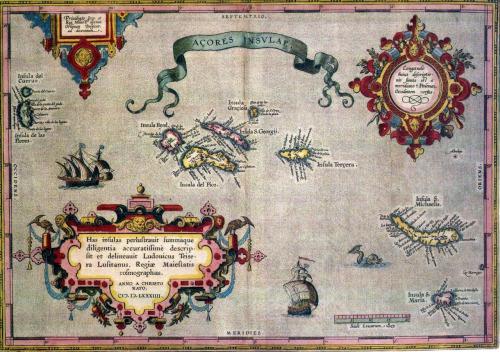 Map of the Azores from 1584Photo: Public domain
Map of the Azores from 1584Photo: Public domain
In 1419, the island of Madeira was discovered by a captain of Henry the Navigator (Portuguese name;Henrique, o Navegador), João Gonçalves Zarco (c. 1390-1471). Madeira was uninhabited and was used as a starting point for other voyages of discovery, one of which resulted in the discovery of the Azores. It is still not entirely certain when that was exactly. Some historians believe that the Azores were accidentally found by returning Portuguese sailors sailing along the African coast or sailing to or from Madeira. However, given the prevailing winds that blow in that region, this is a very unlikely scenario.
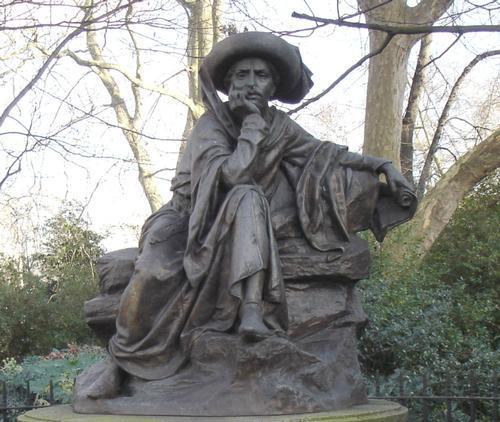
More realistic is the theory that Henry the Navigator sent Goncalo Velho Cabral on a voyage in 1431 with orders to sail west until he encountered an island, knowing that islands were drawn on the Catalan map mentioned above. In 1431 Cabral found a number of volcanic rocks that he called the 'Formigas', and at that time he was only a few dozen kilometers from one of the Azorian islands. He returned to Henry and was immediately ordered to re-explore the area around the present-day Azores archipelago in 1432.
On August 15, 1432, which happened to be the Assumption Day, Cabral found the easternmost island of the Azores, and named it after Maria, Santa Maria. In a letter from Alfonso V, King of Portugal, dated 2 July 1439, the name Azores is mentioned for the first time. The letter mentions seven islands and Henry the Navigator was given the right to colonize the islands. São Miguel was discovered a little later and Terceira was the 'third island' to be discovered. Another popular theory is that the first island, Santa Maria, was discovered in 1427 by Diogo de Silves, also a Portuguese explorer. In any case, Flores and Corvo were the last to be discovered, that's for sure.
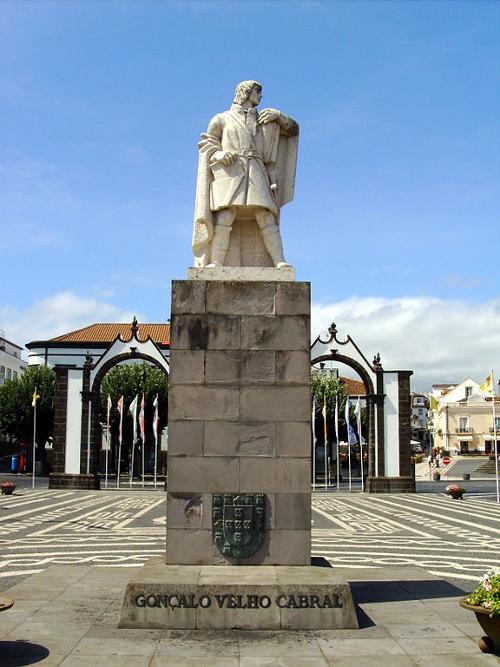 Statue of Goncalo Velho Cabral in Ponta Delgada, São Miguel, Azores Photo: Carlos Luis M C da Cruz in the public domain
Statue of Goncalo Velho Cabral in Ponta Delgada, São Miguel, Azores Photo: Carlos Luis M C da Cruz in the public domain
The colonization of the islands was in a typically medieval way. King Alfonso V gave the islands to his nephew, Henry the Navigator, who was awarded the military order 'Ordem Militar de Avis'. The organization behind this military order sponsored, as it were, the Portuguese voyages of discovery in the 15th century and in return were given the opportunity to colonize and exploit the new lands. Henry the Navigator in turn delegated control of the islands in terms of administration, defense, justice and land allocation to the colonial governor, the 'Capitão Donatário'. This figure also collected a number of taxes and had a monopoly over mills, salt production and bread ovens.
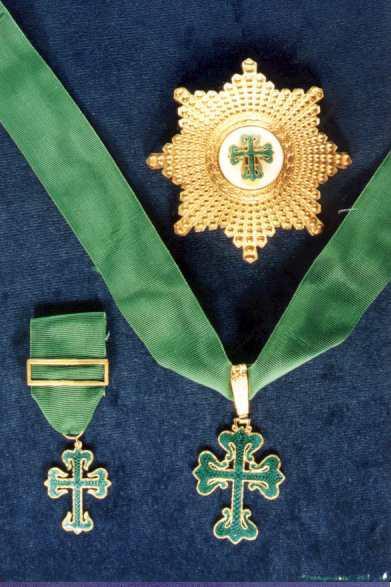 Ordem Militar de Avis, AzoresPhoto: Chancelaria da Presidência da Republica in the public domain
Ordem Militar de Avis, AzoresPhoto: Chancelaria da Presidência da Republica in the public domain
Furthermore, there was an almost fixed pattern when colonizing new land: cows, goats and pigs were imported for meat and the landscape was tackled to start agricultural activities, for example. And for the Azores, tackling the often very dense vegetation was an enormous task. The first islands to be permanently inhabited, the immigrants mainly came from the regions of Algarve and Alentejo on the Portuguese mainland and from the island of Madeira, Santa Maria and São Miguel, followed by Terceira in about 1450. Because there are too few immigrants from Portugal ventured the voyage, Hendrik the Navigator stimulated immigration from Flanders, where many sought refuge to escape the poverty and the scourges of the Hundred Years' War between the French houses of Valois and Plantagenet, which was also fought on Flemish territory. The Flemish gladly accepted this request and in 1466 Josse Van Huerter (Portuguese: Joss de Utra or just Dutra) received the islands of Faial and Pico in concession, a few years later Flores and São Jorge by the Bruges merchant Willem van der Haegen ( Portuguese: Guilherme da Silveira or Guilherme Vanderaga) and Terceira by the Flemish noblehusband Jacob van Brugge.
In total, around 2000 Flemish people left for the Azores, which were soon known in Northern Europe under the name of the Flemish Islands. into the fire. That was sometimes very rigorous, and an island like Pico even got a somewhat rocky character. Settlements were built close to the coast wherever possible, which was not easy due to the inhospitality of the coastline. From here, the interior was gradually colonized and agricultural activities were started that were soon so successful that even in the course of the 16th century it was possible to start exporting, including wheat, sugar and widow blue, which was mainly used as a coloring agent for the textile industry in Flanders. Each island had its own specialties, depending on climate and soil conditions, and exports only really started at the end of the 17th century, when the population started to feed more and more on maize and (sweet) potatoes imported from America.
In the mid-16th century, the Azores benefited from the return of trade ships from India, but it was not until the Portuguese colonization of Brazil and the voyages of discovery to America that accelerated the development of the islands. The coastal town of Angra on the island of Terceira in particular played an important role in this, partly because the sheltered harbor generated a lot of harbor money. Ships returning from Brazil gathered in Angra and set out in convoy and protected by warships towards Lisbon, fearful of the many pirate ships that infested the sea between the Azores and mainland Portugal.
In 1580, the Spanish annexed Castile Portugal. The Azores supported Dom António (António I de Portugal or Anton van Crato), a Portuguese pretender to the throne, who, with the help of France, held out on Terceira, the last stronghold in the fight against the Castilians.
In July In 1582 the Spanish defeated the French fleet at Terceira and in 1583 all the islands of the Azores were conquered and occupied. In 1588, the Spanish Armada suffered a dramatic defeat against the English fleet led by Admiral Charles Howard (1536-1624) and Vice Admiral Francis Drake (ca.1540-1596), while Dutch watergeuzen prevented the Duke of Parma from moving from Flanders to join the Armada. As a result of this defeat, Spanish power in the Azores, also known as the 'Babylonian captivity', was waning and the islands were regularly attacked by English privateers.
In 1591, Spanish rule came to an end, the English attacked the Spanish and from about 1640 until the opening of the Suez Canal in 1869 the Azores became a staging post for English merchant ships and a strategic base for English warships. In the same year, a new king was elected by Portuguese nobles from their own ranks, Johan IV (João IV) of Portugal (actually Duke John II of Bragança) of the House of Bragança.
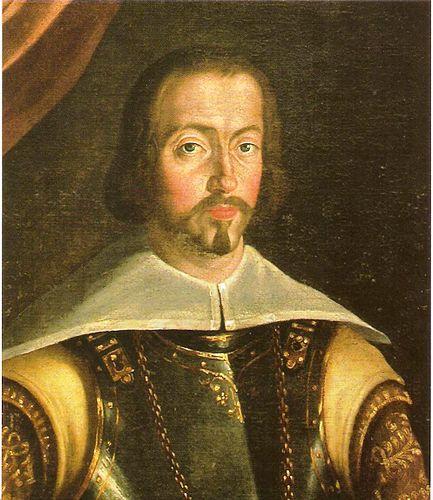 Joao IV of Portugal (1604-1656) Photo: Public domain
Joao IV of Portugal (1604-1656) Photo: Public domain
A war of independence with the Spaniards ensues, the so-called Portuguese Restoration War (1640-1668), and as early as 1642 the Spaniards are expelled from the Azores. It was not until 1668 that Spain recognized the independence of Portugal. From 1656 to 1683, son of Johan IV, Alfonso VI of Portugal (Portuguese: Dom Afonso VI de Portugal) was king of Portugal. The physio and mentally weak Alfons. However, the real leadership was in the hands of Mother and Regent Louisa Maria. Alfons found out through the media that his mother even wanted to remove him from the throne and that was the signal for him to take matters into his own hands, and as the first powerful act he sent his mother into the monastery. After the divorce with his wife Maria, his younger brother Peter, who got married with the same Maria, forced him to surrender power to him and appoint him regent. This Peter was King of Portugal from 1683 to 1706 under the name of Dom Pedro II de Portugal. Alfons had meanwhile been exiled to Terceira for seven years and died the same year his brother became king of Portugal.
For centuries, the Azores did not have a central government, and it was not until 1766 that a governor and captain became appointed general by the statesman and above all economic reformer Sebastião José de Carvalho e Melo, Marquis de Pombal, prime minister since 1750 under King Joseph I of Portugal (Portuguese: Dom José I de Portugal, 1714-1777), nicknamed the 'Reformer' ( Portuguese: o Reformador).
Important for the Azores was that he also introduced administrative reforms by Portgal to be divided into districts and provinces. Thus the Azores became one province, governed by a capitão-general (Portuguese: capitão-general) with Angra on Terceira as the capital. What was not much appreciated by the other islands was the removal of a great deal of autonomy that the islands and their lords had built up over the centuries. Especially the economically important and wealthy São Miguel protested strongly because they were used to solving their problems directly with the central government in Portugal.
In 1807, Napoleon Bonaparte's French troops entered Portugal;Napoleon wanted to end Anglo-Portuguese trade, and demanded that Portugal close its ports to the English ships. However, the Portuguese refused and that triggered the Spanish War of Independence (1807-1814), in which the Portuguese, Spanish and British took on Napoleon's French. The Portuguese royal family and other important figures fled to Brazil, making Rio de Janeiro the temporary capital of Portugal. Portugal was ruled by a military junta during that war with a request not to oppose the occupiers.
In 1808, British and Portuguese troops, led by Sir Arthur Wellesley (later Duke of Wellington), captured Lisbon and the French troops were allowed to leave the country without further violence. At the same time, Napoleon forced the Spanish King Charles IV (1748-1819) to resign and replaced him with his brother, Joseph Bonaparte (1768-1844). The French made two more attempts to invade Portugal, but failed both times and even had to leave Spain in 1814 after a series of defeats. Portugal, and therefore the Azores, had been severely affected by the war violence. And with a king, at that time Johan VI of Portugal (Portuguese: Dom João VI de Portugal), and a government in Brazil, the country was in fact ruled by the English Marshal William Carr Beresford (1768-1856) and British companies had major economic interests in Portugal. The feeling in Portugal and especially in Lisbon was that they had actually become a kind of colony of Brazil.
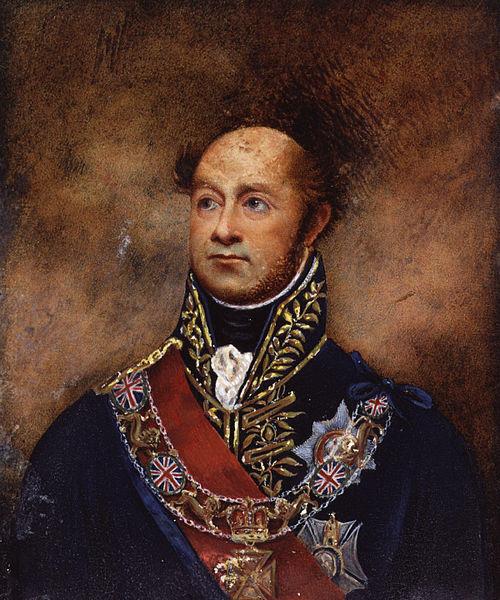 William Carr Beresford, ruler of Portugal and the Azores Photo: Public domain
William Carr Beresford, ruler of Portugal and the Azores Photo: Public domain
In 1820, that sentiment led to the 'Liberal Revolution', which spread across the country from Porto and aimed at the return of the king from Brazil, the declaration of a constitutional monarchy and that Brazil regain colony status. with Portugal's monopoly to trade with Brazil. William Beresford was replaced by a junta and in 1821 a constituent assembly was elected in Lisbon and the first Liberal constitution was published. A few months later, Johan VI returned to Lisbon and his grandson Peter I (Portuguese: Dom Pedro) remained as regent in Brazil. That same year, the Empire of Brazil was dissolved and brought back under the direct control of Lisbon. At least, that's what they thought, because in 1822 Peter proclaimed himself Emperor of Brazil and detached the colony from the motherland by defeating the last Portuguese troops in 1824.
In Portugal, the new constitution left the king hardly any more. power, much to the dissatisfaction of Johan VI's wife, Carlota-Joaquina, who organized an uprising with her son Dom Miguel. A period of great unrest followed, which worsened after the death of Johan VI in 1826, after which Peter I was proclaimed King of Portugal for a very short period (March 10, 1826- May 2, 1826) and was then succeeded by his eldest daughter., Dona Maria II. In 1828 the Portuguese throne was taken over by Prince Dom Miguel, youngest brother of Peter I. The Liberals in the government, dissatisfied or even persecuted by the new absolute regime, left for loyal Terceira.
Meanwhile, Brazil was also facing a political crisis and Peter I resigned on April 7, 1831 in favor of his son Peter II. Peter I left for Europe in July 1832 to take on his brother Dom Miguel, this is called the Miguelist War. He first went to England because many Liberals had fled there, and from there to Terceira to set up a government-in-exile there. In July of the same year he, together with the French and English, conquered Porto in the north. The Duke of Terceira conquered Lisbon and in 1834 took control of all of Portugal. Peter I died of tuberculosis on September 24.
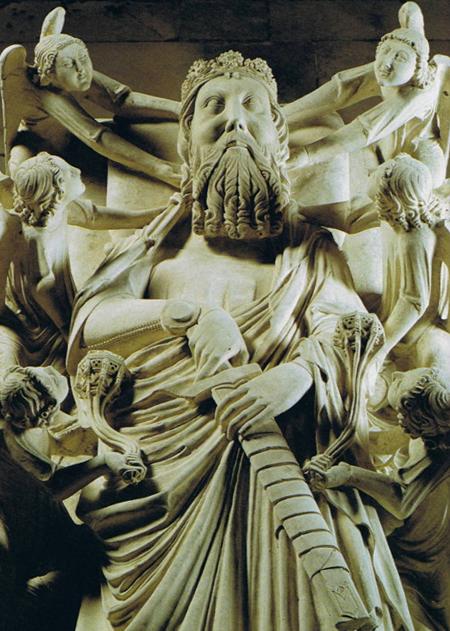 Tombe Peter I van PortugalPhoto: Public domain
Tombe Peter I van PortugalPhoto: Public domain
Reforms were now the order of the day and the Azores officially became a province of Portugal with Angra as its capital. The island of São Miguel protested strongly against Terceira's dominance and this conflict was eventually resolved by creating first two districts and then a third. São Miguel and Santa Maria were then under the Ponta Delgada District, while Angra controlled Terceira, Graciosa and São Jorge. The Horta district was in charge of Faial, Pico, Flores and Corvo. Each district was independent from the other and negotiated and consulted separately with the central authority in Lisbon. The provincial governor was appointed by Lisbon.
Already at this time the idea of territorial division started which later led to districts with far-reaching autonomy until 1974. Matters such as taxes triggered that process, such as in 1869 the 'Dízimo'. tax that required the population to hand over 10% of income to the Church. Later, a tax on Azorian alcohol followed to protect the beverage industry on the mainland. In 1864, orange cultivation was killed by insect pests, but the pineapple, grown in greenhouses, became a new export product, especially from the island of São Miguel. Important for Portugal and the Azores in 1893 was the construction of the first sea cable between the island of Faial and mainland Portugal. The city of Horta later became important as a relay station for transatlantic communications.
Portugal manages to avoid the violence of World War II, with the exception of a number of Allied bases in the Azores. Whaling from the Azores benefited enormously from this without the presence of competition, especially from the United States. Prime Minister and later President Salazar led the authoritarian right-wing government that ruled Portugal from 1932 to 1974. Despite his dictatorship, he ensured in those years for peace among the population and for political and financial stability. There was primary education for everyone and a lot was invested in the infrastructure. Many of the popular schools in the Azores date back to this time. After his death, a left-wing coup changed the regime towards democracy, free elections and the first constitutional government took office in 1976. In the same year, the Azores became an autonomous region with its own president and government, who also elected five delegates to the rural parliament in Lisbon.
In 1980, the historic city of Angra do Herosmo on the island of Terceira was largely destroyed and later rebuilt with the help of UNESCO and American aid. UNESCO also immediately declared the city a World Heritage Site. A few years later, in 1984, another setback for the Azores. Whaling causes so many losses that it is no longer economically viable to maintain a whaling fleet. On the island of Pico, the last whale processing factory also closed its doors, which meant that from that date onwards, whales became increasingly important to the Azores only from a tourist point of view.
In 1986 good news for the Azorean economy. Portugal joined the European Union (then the European Community) in that year and the Azores received large sums from Brussels in subsidies for infrastructure and job creation, especially in tourism.
In 1998, the Azores, and in particular the islands of Faial and Pico, shaken by an earthquake that killed eight people and caused extensive damage to the houses on those islands.
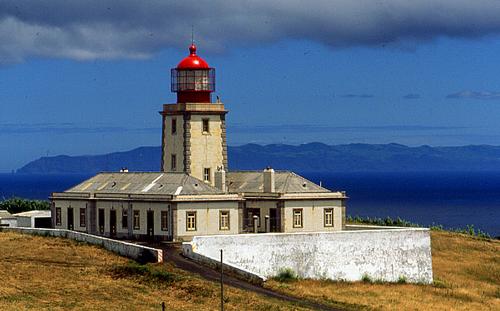 The Ribeirinka Lighthouse on Faial before the 1998 earthquake Photo: Public domain
The Ribeirinka Lighthouse on Faial before the 1998 earthquake Photo: Public domain
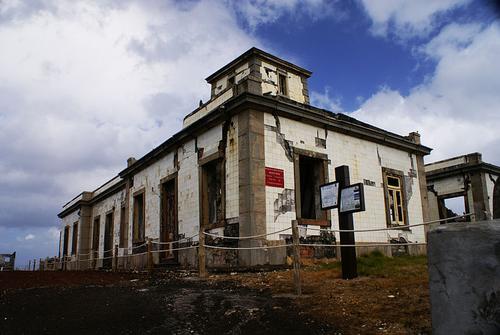 The Ribeirinha lighthouse on Faial after the 1998 earthquakePhoto: Public domain
The Ribeirinha lighthouse on Faial after the 1998 earthquakePhoto: Public domain
The winegrowing area on Pico with its characteristic wine farms and walled vineyards was declared a UNESCO World Heritage Site in 2004;After Graciosa and Corvo a few years earlier, Flores was declared a Biosphere Reserve.
In 2013, the economic crisis that started in 2008 was also felt in the Azores. Holidaymakers from Portugal, who account for half of all tourists, stay away in large numbers, fortunately the number of foreign tourists remained fairly stable during those difficult times.
Brief history of the islands
São Miguel
São Miguel was discovered almost at the same time as Santa Maria in 1427 by the Portuguese explorer Diogo de Silves. The first settlers on São Miguel not only came from the Portuguese provinces of Extremadura, Alentejo and Algarve, but Jews, Moors, French and Madeira residents also settled on São Miguel. The island's first capital was Vila Franca do Campo, but an earthquake and violent mudslides in 1522 devastated the city, killing almost all residents.
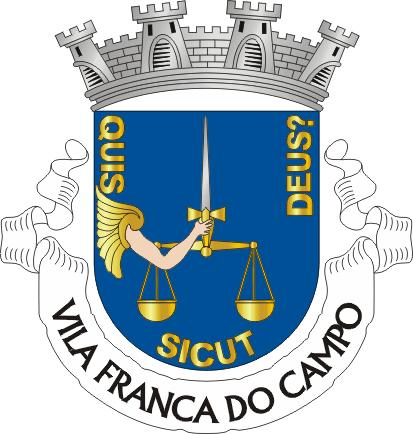 Coat of arms of Vila Franca do Campo, Azores Photo: Sérgio Horta CC 3.0 Unported no changes made
Coat of arms of Vila Franca do Campo, Azores Photo: Sérgio Horta CC 3.0 Unported no changes made
In 1546, Ponta Delgada, with an important port and located in a more earthquake-resistant location, became the new capital of São Miguel. At that time there were already wealthy merchants on the island who traded with Portugal, Madeira, the Canary Islands and Flanders, among others. but there was also trade with England, in one year dozens of English merchant ships called São Miguel. Agricultural products of the time were mainly wheat, woad (for making the color widow blue), sugar cane and dairy products. From 1582 São Miguel was occupied by Spanish troops and exploited for years until independence in 1640. In the 16th and 17th centuries, the port of São Miguel was fortified against the attacks of pirates and corsairs. Terceira was the main island of the Azores at the time, but that changed in favor of São Miguel after the Portuguese independence in 1640. During the 18th and early 19th century the island flourished economically, mainly due to the cultivation of oranges, mainly exported to England were exported. At that time many houses, but also the necessary churches were built.
In 1831-1832 the resistance against the absolutist regime of that time was organized from São Miguel. From Ponta delgada 3,500 liberal Azorians left for Northern Portugal. From 1860, orange cultivation collapsed due to cheaper alternatives from Portugal and Spain and harmful insects that transmit diseases. This eventually resulted in an economic crisis and increased emigration to North and South America. Instead of oranges, tea, pineapples, chicory, sugar beets and tobacco were now grown, along with livestock farming and, later, fishing. In 1861 the port of Ponta Delgada was modernized, which in turn attracted industrial activity. In 1947, the port was again majorly tackled. On January 9, 1976, the first and so far only university in the Azores, the 'Universidade dos Açores' in Ponta Delgada, opened its doors.
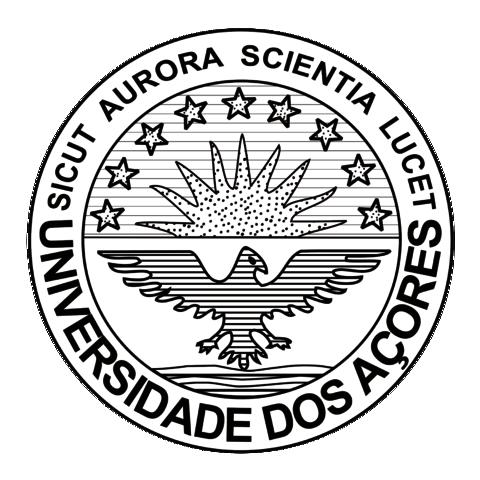 Logo of the Universidade dos Açores Photo: Universidade dos Açores in the public domain
Logo of the Universidade dos Açores Photo: Universidade dos Açores in the public domain
Santa Maria
Santa Maria is believed to have been the first island of the Azores to be discovered in 1427, in this case by the Portuguese explorer Diogo de Silves. The name Santa Maria would have been chosen because on the day the island was first seen, it was the Assumption of Mary on that day. Santa Maria was also the first island to be settled by colonists, initially by Gonçalo Velho Cabral. That was in the year 1439 and they mainly came from the Portuguese regions of Algarve and Alentejo. They initially settled on the northwest coast at a place called Praia do Lobos, west of present-day Anjos, by the river Ribeira do Capitão (now Ribeira de Santana).
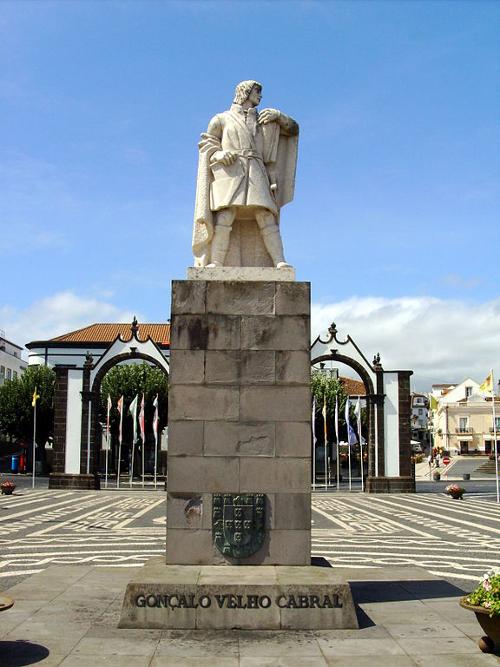 Gonçalo Velho Cabral (c. 1400- c. 1460), colonizer of Santa Maria, AzoresPhoto: Carlos Luis M C da Cruz in the public domain
Gonçalo Velho Cabral (c. 1400- c. 1460), colonizer of Santa Maria, AzoresPhoto: Carlos Luis M C da Cruz in the public domain
Between 1460 and 1474 Vila do Porto developed, in 1472 it was granted city rights, however, it became the administrative center of Santa Maria and exported woad (blue) and urzela, two dyes that were frequently used in the textile industry at the time. At the time, Santa Maria acted as a sort of commercial satellite of São Miguel, supplying that larger island with wheat, orseille (purple dye from lichen), woad (dye for dyers in Flanders), pottery clay and cheese. During the 16th and 17th centuries, Santa Maria was severely affected by constant attacks from French, Turkish and Moorish pirates, which also destroyed settlements. At the beginning of the 19th century, demand for the products produced on Santa Maria virtually came to a standstill and dealt a serious blow to the island's economy. As a result, many residents of the islandd left for other countries, especially North and South America.
It was not until World War II that Santa Maria came into the picture again with the construction of an American air base on the island, which was later expanded into an airfield suitable transatlantic flights;in 1977 the first Concorde landed at the airport. An air traffic control center for North Atlantic airspace is currently located at Santa Maria.
Terceira
Terceira's original name was 'Ilha de Jesus Cristo' (Jesus Christ), but was later called Terceira because it was the third Azores island to be discovered in 1434, after São Miguel and Santa Maria. The first settlers arrived and were led by Jacob van Brugge, the son of a wealthy merchant family from Bruges. As on São Miguel and Santa Maria, agriculture was important to Terceira, mainly cereals and woad (blue) were grown there. The first settlements were founded in the vicinity of the current places Porto Judeu and Praia da Vitória. Even more important to Terceira was the presence of a sheltered natural harbor, making it the main island of the Azores for centuries.
 Map of Terceira by Jan Huygen van Linschoten (ca. 1563-1611)Photo: Public domain
Map of Terceira by Jan Huygen van Linschoten (ca. 1563-1611)Photo: Public domain
In 1534, Angra became the first settlement to be considered a real city, and that same year, Pope Paul III proclaimed Angra the seat of the diocese. In 1580 Terceira managed to resist the Spaniards like a stronghold, who had already annexed all of Portugal. The Portuguese Dom Antonio was helped by the French. But this last stronghold also became prey for the Spaniards, who defeated the French fleet near Terceira in 1582 (Battle of Punta Delgada or Battle of Terceira). In 1583 Terceira was finally taken by the Spaniards and the population was severely punished for their resistance to the Spaniards. In the 16th and 17th centuries, the port became increasingly important to the Spaniards. The ships loaded with gold and silver from the Americas gathered in the port of Terceira and then sailed in convoy and under protection to the Spanish port of Cadiz, afraid of being ambushed by pirates. Later in the 17th century, the Spanish no longer needed Terceira and the island's economy collapsed like a plum pudding, followed by massive emigration to the 'promised' land of Brazil.
After the Portuguese Restoration War (1640-1668) bringing an end to Spanish rule, the Azores became a staging post for British merchant ships until the opening of the Suez Canal in 1863. The economy also recovered from the export of oranges, but there too came again. an end to cheaper alternatives from Spain and Madeira and harmful insects. The result was again that an emigration wave started. Together with the island of São Miguel, Terceira played a major role in the so-called Miguelist War between the Liberals and the Absolutists and eventually Terceira was the only Liberal stronghold left in all of Portugal. In 1829, the Absolutists tried in vain to land on Terceira near the town of Villa da Praia and the Liberals' triumph resulted in a name change: Praia da Vitória. In 1832, Liberal units left Terceira and São Miguel and advanced north of Portugal in their fight against the absolutists.
In 1766, the Azores received a central government, which was stationed in Angra, which remained the capital until 1833. time the Azores were divided into three districts. A short time later, Angra was even proclaimed the capital of Portugal when King Peter IV resided briefly on Terceira and the name of that city was changed to Angra do Heroísmo. In 1943 Lajes airfield was built to support the Battle of the Atlantic Ocean and to drop airborne troops in Europe. At present, the airport is still serving in a strategic NATO role, in addition to a civil aviation target. On New Year's Day 1980, an earthquake caused serious damage to Terceira, Graciosa and São Jorge. Many important buildings in Angra do Heroísmo were seriously damaged and it took a long time for the city to be restored to all its splendor. When that was completed, the city was declared a UNESCO World Heritage Site in 1983. It is worth noting that the Faculty of Agriculture of the Universidade dos Açores is located in Terceira.
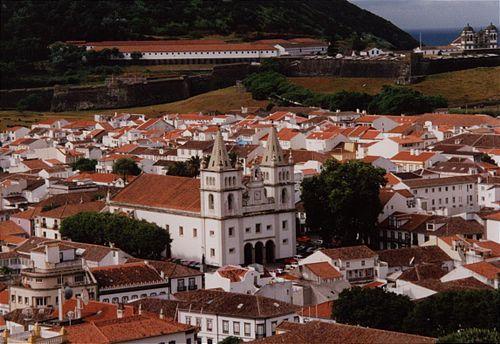 Overview of the historic inner cityCity of Angra do HeroísmoPhoto: Martin Herbst CC 2.0 Duitsland no changes made
Overview of the historic inner cityCity of Angra do HeroísmoPhoto: Martin Herbst CC 2.0 Duitsland no changes made
Graciosa
No doubt sailors who discovered Terceira have also discovered the island of Graciosa, because the distance between the two islands is less than 100 km, but that is not certain. In any case, it is certain that Hendrik de Zeevaaerder had cattle released to Graciosa in 1440. The most famous settler who also immediately tackled the dense vegetation of the island was Vasco Gil Sodré, who originally lived in Montemoro-o-Velho on the west coast of Portugal and settled on Graciosa in the town of Carapacho on the far south coast of Graciosa since 1450. He did not eventually become governor, he became Christopher Columbus's brother-in-law. Most of the settlers came from the Beiras and Minho regions of Portugal and from Flanders. Santa Cruz received city rights in 1486.
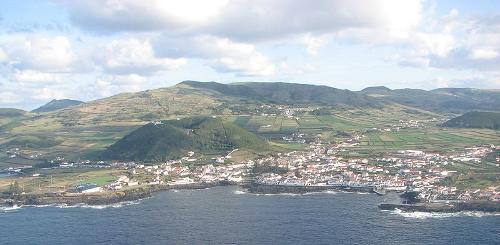 Santa Cruz da Graciosa, AzoresPhoto: Angrense in the public domain
Santa Cruz da Graciosa, AzoresPhoto: Angrense in the public domain
Graciosa soon turned out to be extremely suitable for growing grains and grapes, and wheat, barley, wine and brandy were already being exported within a century of the first settlers' settlement. These products were first shipped to the Azorean economic and administrative center, Terceira, which could also receive large ships in its port, and from there to Portugal and other export destinations around the world. The prosperity that this brought naturally also attracted pirates, and thirteen fortresses were built for defense and grain was hidden in underground cellars. The grape louse collapsed viticulture in the second half of the 19th century, immediately resulting in a wave of emigration. Today, Graciosa, as on almost all islands, mainly produces meat and dairy products. Fishing is hampered by the severe decline in the numbers of fish still found in the waters around the Azores.
Graciosa had about 14,000 inhabitants at its peak, but emigration caused this number to drop rapidly. Even in the 1950s, despite measures taken by the government to combat this, there was still a considerable flow of emigration, so that in the end there were only about 4000 people living on Graciosa.
São Jorge
São Jorge, along with other islands of the central archipelago, was discovered by Portuguese navigators around 1430. Topo, located in the far east of São Jorge and also called Nossa Senhora do Rosário, was founded by the Flemish colonizer, merchant and nobleman Willem Van Der Haegen, who later called himself 'Guilherme da Silveira'. At that time, Isabella of Burgundy asked her brother Alfons V of Portugal the right to usufruct of the Azores. The population of Flanders was very poor and they saw a solution by allowing Flemish people to live on the islands of the Azores and to build a life there. Willem Van Der Haegen was assigned São Jorge, sailed to the island with two ships and some traders in 1466, later he also colonized Flores.
Velas was founded in the mid-15th century and developed so quickly that it was barely fifty years old. later already received city rights. The economy of this city was based on the export and production of wool, orseille (purple dye from lichen), wheat and grapes. Three centuries later, oranges became a lucrative export product, being shipped to England by boats at the same time. In 1850 viticulture was affected by grape lice and orange cultivation ten years later by mildew. Both disasters were followed by a flow of emigration, which reduced the population by half in less than a hundred years.
Until the construction of an airport in the 20th century, São Jorge remained a fairly isolated island. The main products of the island are currently meat and especially cheese, three factories are engaged in the production of the famous São Jorge cheese. Economically, things are not going so well with São Jorge at the moment. Like all the other islands of the Azores, São Jorge suffered from pirate attacks, earthquakes and volcanic eruptions as many as six times over time, between 1580 and 1907. In 1980 São Jorge was hit by the worst earthquake in history, 7.0 on the Richter Scale. Most fajãs (coastal villages) were abandoned after the disaster and were left as ghost villages.
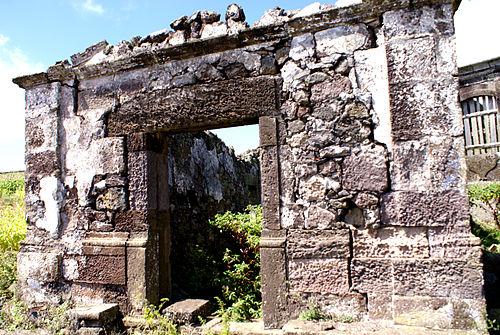 Door of the chapel Solar dos Tiagos, where Willem Vander Haegen is buriedPhoto: José Luís Ávila Silveira/Pedro Noronha e Costa
Door of the chapel Solar dos Tiagos, where Willem Vander Haegen is buriedPhoto: José Luís Ávila Silveira/Pedro Noronha e Costa
Faial
On old maps, the current Faial is mentioned as 'Insule de Ventura', which was discovered by the Portuguese in the first half of the 15th century and immediately colonized. Under the leadership of Josse Van Hurtere, a small number of Flemings settled on the island, a number that had risen barely twenty years later to about 1500. They initially settled in Praia do Almoxarife, later mainly in Vale dos Flamengos, now Flamengos, not far from the capital Horta.
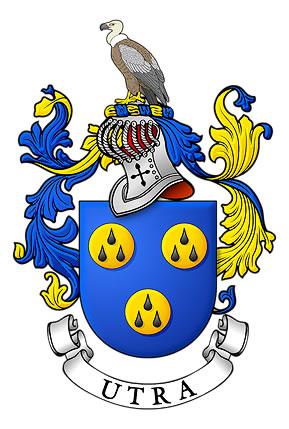 Coat of arms of the House of Utra, descendants of the Van Hurtere familyPhoto: Alvexibl in the public domain
Coat of arms of the House of Utra, descendants of the Van Hurtere familyPhoto: Alvexibl in the public domain
The Azores have always held an important position in the history of the Atlantic Ocean. Numerous Portuguese ships returned from their voyages to the West Indian area and sought protection from piracy. The port of Horta then also became an important refuge for the English settlers in North America, but Horta was also a focal point for the provision and repair of ships and the embarkation of sailors. In addition to exports to other countries, there were also many trade activities between the islands and mainland Portugal.
In 1583, the Spanish attacked Faial and captured Santa Cruz Fort. During the Spanish occupation, the English attacked the island several times. Sir Walter Raleigh succeeded, destroying in passing a Spanish fleet that had been to Mexico. In 1672, Faial was shaken by an earthquake that caused major devastation. A peaceful guest was Captain James Cook, who checked his equipment in 1775 before traveling to the southern seas. All the whalers also came to visit Horta to replenish their supplies, recruit crews, and later warehouses and other facilities were built that brought more ships to Horta. One of them was the American John Dabney (1766-1826), who arrived on Faial in the early 19th century and whose family had a major influence on commercial activities for a century, including the export of oranges, wine from Pico Island and whale products.
In 1866 the first reliable transatlantic telegraph cable was laid from Faial, connecting many parts of the earth fifty years later. In 1892 an English company laid the first cable between Ponta Delgada and further to the coast south of Lisbon. From 1900 cables were laid between the United States, Germany, Ireland, Cornwall in England and via Cape Verde connections were made with cables to Africa and South America. At the time, British, Germans, Americans and Portuguese technicians worked and the last cable from Horta was laid in 1928. Horta remained one of the most important cable centers in the world until 1969, but in that year the last cable company left because modern systems did not need to run via the Azores.
The cable laid in the late 19th century also allowed weather data transmitted faster for accurate weather forecasts. In addition, the Prince Albert of Monaco Observatory was built in 1901. In 1919, via Horta, among others, the first transatlantic crossing by plane was realized by the pilot Albert Cushing Read (1887-1967). The famous pilot Charles Lindbergh also reported to Faial, he investigated in 1933 whether the Pan-Am planes could land on Faial. That turned out to be possible and Pan-Am was followed by Lufthansa, Air France and Imperial Airways, now British Airways. In 1957/1958 Faial was hit by very violent volcanic eruptions, resulting in the creation of a new 2.4 km2 headland. Thousands of people emigrated to safer places.
On January 9, 1976, the first and only university in the Azores, the Universidade dos Açores in São Miguel, opened its doors. The Faculty of Oceanography and Fisheries started its classes at Faial on the same day. The first non-natural harbor on Faial was built in Horta on 3 June 1986. In 1998 the east of Faial was badly hit by a major earthquake. Faial's economy currently revolves around agriculture, dairy, fishing, trade and tourism.
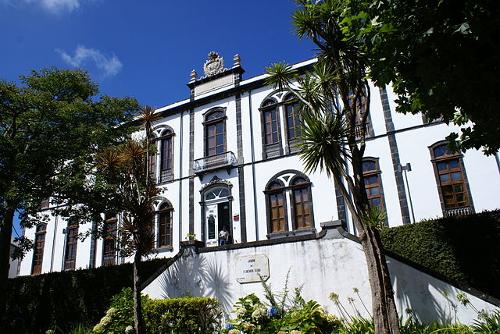 Faculty Building Oceanography and Fisheries on FaialPhoto: José Luís Ávila Silveira in the public domain
Faculty Building Oceanography and Fisheries on FaialPhoto: José Luís Ávila Silveira in the public domain
Pico
Pico was discovered in 1450 by the Flemish nobleman Jacob van Brugge. The first houses on the island of Pico were probablybuilt in Ribeiras, but the real colonization started around 1460 in the current region around Lajes, which for many years was the most important (port) place on Pico. Later, Lajes would become the center of the whaling industry in the Azores. São Roque dates back to 1542, probably by inhabitants of the island of Graciosa. São Roque would also become an important place for the whaling industry.
Until the second half of the 19th century, the production of wine would also be important for the economy of the island, especially the Pico Madeira was in large quantities, via the port of Horta on Faial Island, exported to England, the United States and especially to Russia. The vineyards along the west coast south of the town of Madalena were in fact owned by six families from Horta on the island of Faial. Pico by the Phylloxera aphid. This was a major blow to the economy and many islanders fled to countries such as Brazil and the United States, especially California, to build a new future. Later, returning islanders brought with them the American Isabella grape, which started again on a modest scale with the production of wine, the 'Vinho de Cheiro', for local consumption.
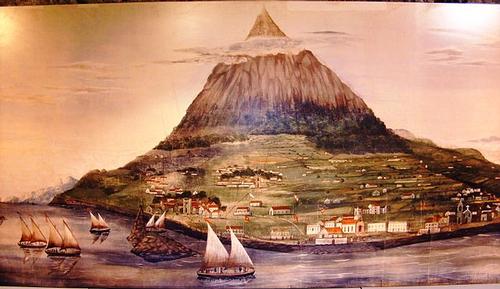 Ilha do Pico Benjamin Russell&Caleb PurringtonPhoto: Public domain
Ilha do Pico Benjamin Russell&Caleb PurringtonPhoto: Public domain
At that time whaling became increasingly important to Pico and whale-related factories were also opened there. But this economic activity also came to an end due to the sharply reduced demand for whale products. Many factories closed and in 1984 the last whale was killed. At the moment, livestock and dairy production is important to Pico, Madalena still has a fleet for tuna fishing and tourism is becoming increasingly important.
Flores
The name Flores probably derives from the many yellow flowers that the Portuguese discoverers of Flores found on the coast. The so-called 'cubres' are in reality Solidago sempervirens, a goldenrod species native to the North American coasts. In about 1452 Flores was discovered by Captain Diogo de Teive and his son João de Teive, of which he became captain for some time. For a few years he passed the rights of Flores over to his son João, who sold the rights on again in 1474 to Fernão Teles de Meneses and his wife Maria de Vilhena.
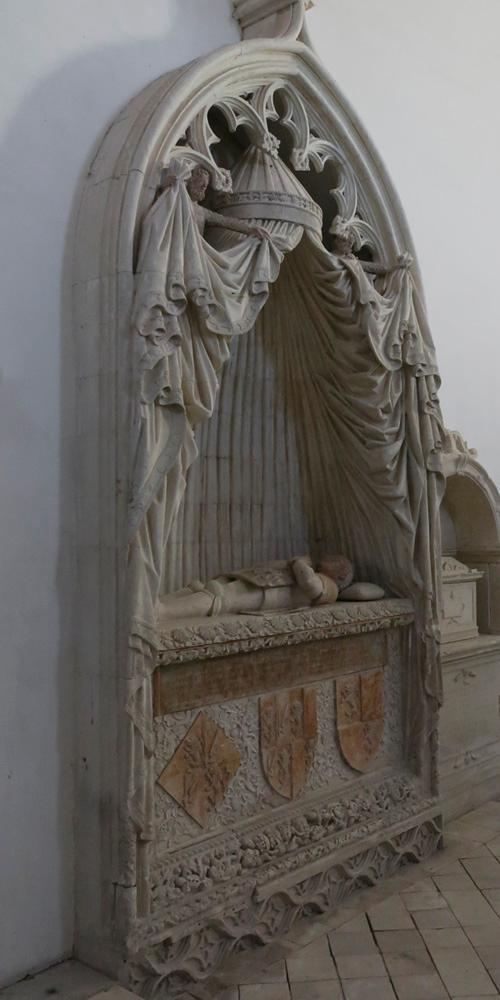 Tomb of Fernão Teles de Meneses (1431-1477) in Coïmbra, PortugalPhoto: Manuelvbotelho CC 4.0 International no changes made
Tomb of Fernão Teles de Meneses (1431-1477) in Coïmbra, PortugalPhoto: Manuelvbotelho CC 4.0 International no changes made
The first colonization attempt, however, was made by the Flemish nobleman Willem Vander Haegen. He tried to grow woad on Flores to produce widow blue, a colorant that was gladly used in the Flemish textile industry. Unfortunately, that failed for him due to the remoteness of Flores and the lack of a natural harbor, after which Vander Haegen withdrew to Topo on the island of São Jorge.
Permanent residence did not start until 1504 under the leadership of Captain João da Fonseca with people from Portugal, Terceira and Madeira, supplemented by Spaniards, Germans, English, Jews and Moors. Around 1515 Lajes received city rights, thirty years later Santa Cruz and at the end of the 16th century Ponta Delgada. It is estimated that at that time about 1,300 inhabitants lived on Flores in very primitive conditions, with only occasional visits from a ship from Terceira in the climatically favorable times.
Flores was also regularly attacked in the 16th century. by English pirates and in June 1587 Lajes was destroyed by five English ships. In 1591, a battle was fought near Flores between a British squadron and a Spanish convoy that returned from Mexico loaded with gold and silver. The Spanish organized two large protected convoys each year, the 'Flota' and the 'Galeones', and the Flota convoy was attacked by the English. However, many Englishmen were ill and stayed ashore at that time, and eventually the English had to surrender under the leadership of the mortally wounded Sir Richard Grenville (1542-1591).
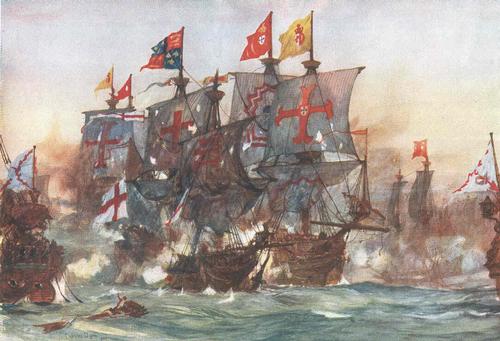 Battle of Flores (1591), AzoresPhoto: Public domain
Battle of Flores (1591), AzoresPhoto: Public domain
In 1770 Lajes was created from the seabombed by two American privateers, but Flores was able to hold its own and later that century trade between Flores and America was resumed. Early economic activities focused on self-preservation, sweet potato or yam, potatoes and other vegetables, fish and bread. For export, widow blue was mainly produced, along with some dragon's blood (red resin) and wool. In addition, some ship repairs, and in the mid-18th century whalers were supplied, in the mid-19th century meat, fruit and vegetables were exchanged or sold to the other islands of the Azores, Madeira and mainland Portugal. The population of Flores peaked around that time, but has now dropped to less than 4,000 over the course of 150 years. Whaling from Flores began in 1860 and peaked in the 1930s. Some factories were built in Santa Cruz and later in Lajes, but due to the lack of a good port, this industry did not really get off the ground. The last whale was killed in 1981 and the whaling and whaling industry was finally over.
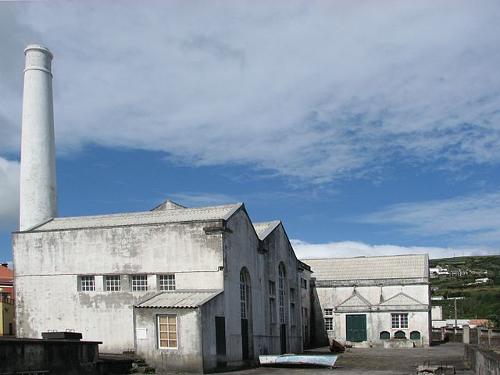 Boqueirão whale factory, active from the late 19th century to the early 20th century in Flores, AzoresPhoto: Angrense in the public domain
Boqueirão whale factory, active from the late 19th century to the early 20th century in Flores, AzoresPhoto: Angrense in the public domain
In 1906, Flores made the headlines when the cruiser Slavonia sank off the coast of Flores and sent an SOS signal for the first time in world history. For a long time, the infrastructure on Flores was far below standard, it was not until the 1950s that this started to change. The isolation that Flores has suffered throughout its history came to a definitive end with the construction of an airport, improved port facilities and the establishment of a French observatory and telecommunications post, which operated until 1994. French scientists have been studying the formation of depression since 1890, followed by 35 French soldiers and their families in 1964. In 1994 the military left Flores again.
In 2009, Flores was declared a biosphere reserve by UNESCO. At the moment, meat and tourism is the main source of income for Flores.
Corvo
Of all the Azorian islands, Corvo and Flores were the last two to be discovered by the Portuguese explorers. Corvo was discovered in 1452 by Captain Diogo de Teive, and in that early period it often changed its name: 'Ilha de Santa Iria', 'Ilha do Marco', 'Ilha de São Tomas' and Ilhéu das Flores'. After that, the island gradually took its current name, from 'Insula Corvi Marini' to 'Ilha dos Corvos Marinhos' or 'island of cormorants'.
Initial attempts to colonize the island failed, only in 1548, probably after the reclamation. of slaves from Cape Verde, Captain Gonçalo de Sousa managed to establish the first permanent settlement on Corvo. Because of the small area, without a safe harbor and because of the isolated location, the residents have always remained dependent on agriculture and livestock. At the time, communication with nearby Flores was done via fire signals, and in the days of pirates and privatists, the island was left alone in exchange for the provision of water and food and the ability to repair ships.
American whalers in the 18th and 19th centuries provided a lot of work for the population, and later they also went out to sea with their own boats for some income.
In 1830, about 3,000 sheep grazed on the island, in In 1832, Vila Nova received city rights, the first boys 'school was opened in 1845, the first girls' school in 1874. Corvo depended on imports for almost everything, including sugar, flour, coffee, wine, vinegar, brandy, port, cheese from São Jorge, figs, candles, soap and leather;cows and hides were exported. Living conditions were tough on Corvo, however, and as on other Azorean islands, emigration was commonplace, to Brazil, but especially to North America. In 1864 the population was just over a thousand, at the moment about 400. It was not until 1963 that the Corvo got electricity and in 1993 the airport was opened. In 2007, Corvo was declared a UNESCO Biosphere Reserve.
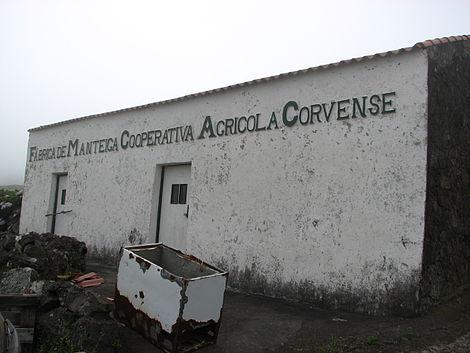 Fabrica da Manteiga Cooperative Agrícola Corvense, an abandoned butter factory on CorvoPhoto: Angrense in the public domain
Fabrica da Manteiga Cooperative Agrícola Corvense, an abandoned butter factory on CorvoPhoto: Angrense in the public domain
Sources
BBC - Country Profiles
CIA - World Factbook
Elmar Landeninformatie
Lipps, Susanne / Azoren
ANWB
Marsh, Terry / Azores
New Holland
Martin, Roman / Azoren
Elmar
Sayers, David / Azores
Bradt Travel Guides
Stieglitz, Andreas / Landscapes of the Azores : a countryside guide
Sunflower Books
Wikipedia
Copyright: Team The World of Info